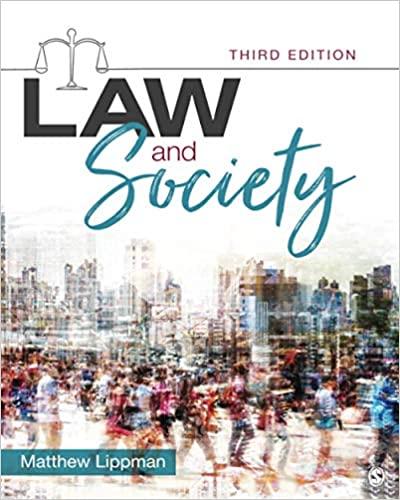Question
AC312-Tax Research Memo #1. I already have the memo. But I am not sure if it is correct. Please Advise. Tax Research Memo #1 Date:
AC312-Tax Research Memo #1. I already have the memo. But I am not sure if it is correct. Please Advise.
Tax Research Memo #1
Date: November 7, 2020
To: Millie and Bob
From: Celia Garcia
Subject: Gnome Business Plan
Facts
Millie and Bob would like to create a new business on design and construction of whimsical garden gnomes.
Issue
1.Tax law that permits a deduction of 20% of the income.
2.Decide on a C-corporation or S-Corporation.
3.Use of the 3.8% net investment income tax.
4.Person liable for the tax of 3.8% net investment.
5.Date to incorporate the S-corporation.
1.The S-corporation allows you to deduct 20% of income under the taxable income below:
Single $157,500
Married $$315,000
Filing jointly may qualify
A C-Corporation does not qualify for this deduction; however, they do qualify for a low 21% corporate tax rate on their income.
2.S-corporation vs. C-corporation share some qualities:
Limited liability protection
Separate legal entities
Filing Documents
Structure
Corporate formalities
Different Taxation:
C-corporations are separately taxable entities.
S-corporations are pass-through taxation entities.
Internal Revenue Code does place several restrictions on who can be shareholders in order for the corporation to qualify as an S-corporation.
S-corporation
Advantages:
A.Single layer of taxation: any distribution of income to shareholders is taxed at the individual level.
B.20% qualified business income deduction: deduction of up to 20% of net qualified business income.
C.Pass-through of losses: pass-through to shareholders, who can use the losses to offset taxable income.
D.Ease of conversion.
E.Rigid profit and loss allocation.
F.Corporate formalities.
G.Asset protection.
H.Cash method of accounting.
Disadvantages:
A.Limited number of shareholders: cannot have more than 100 shareholders.
B.Shareholder restrictions: shareholders must be individuals with a few exceptions and U.S. citizens or residents.
C.Preferred stock not allowed; cannot have different classes of stock.
D.Transfer restrictions: restriction on shareholders to sell or transfer their shares.
C-corporations
Advantages:
A.Unlimited number of shareholders:
B.No restrictions on classes: can issue more than one class of stock preferences for dividends and distributions.
C.Lower maximum tax rate: The 2017 tax reform act lowered the corporate tax rate to a flat 21% and eliminated the alternative minimum tax.
D.More options for raising capital: easier to obtain equity financing.
Disadvantages:
A.Double taxation: corporation pays tax on its earning and the shareholders pay tax on dividends.
Plan on S-corporation if this is applied:
A.Plan to sell shares to no more than 100 people or any other investor not permitted by Subchapter S.
B.No issuing preferred stock.
C.The shareholders' tax liability will be taking into account their personal income tax rate, deductions, and exemptions. Taxes will be lower using a pass-through entity than a separately taxed entity.
D.You will have losses that you will be able to deduct from your personal income taxes to offset income, resulting in a tax savings.
Plan on C-corporation if this applied:
A.Plan to sell shares to over 100 shareholders or other investors permitted by Subchapter C.
B.Distributions will not be made to shareholders.
C.Plan to seek investors.
D.Shares to be freely transferable.
E.Issue preferred stock.
3.The individuals will owe the tax if they have a net investment income. This will be taxed at a rate of 3.8%. Modified adjusted gross income will apply if over the following thresholds. Whichever is the smaller value will be used:
Filing StatusThreshold Amount
Married filing jointly$250,000
Married filing separately$125,000
Single$200,000
Head of household (with qualifying person) $200,000
Qualifying widow(er) with dependent child$250,000
4.The deadline for filing your initial 1120S, as well as all future returns, is always the 15th day of the third month following the close of the S corporation's tax year. You have to report on a calendar year basis. S-corporation's tax year always ends on Dec. 31, which makes the deadline March 15.
Conclusion
An S corporation will allow Gnome's income to be deducted at 20%.
Analysis
A small business S-corporation in any taxable year is under Sec 1362(a)(1). The S-corporation as a pass-through entity allows the owners to deduct up to 20% of the qualified business income on their individual taxes. IRC 199A(A)Allowance of deduction. Initially this will allow "Oh Gnome You Didn't" business costs to be used for income purposes up to 20%.
My recommendation according to your business model is to start with an S-corporation because you are starting with a small business and you mention that you would like to avoid double taxation on the corporate income and a second tax on amounts distributed to shareholders. The corporation will most likely have an operating loss in its first few years. Later if you would like to expand the business, a conversion to a C corporation would be an advantage to allow for a more robust investing structure.
Step by Step Solution
There are 3 Steps involved in it
Step: 1

Get Instant Access to Expert-Tailored Solutions
See step-by-step solutions with expert insights and AI powered tools for academic success
Step: 2

Step: 3

Ace Your Homework with AI
Get the answers you need in no time with our AI-driven, step-by-step assistance
Get Started


